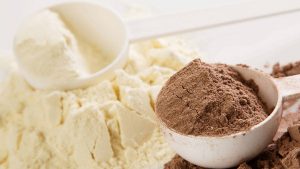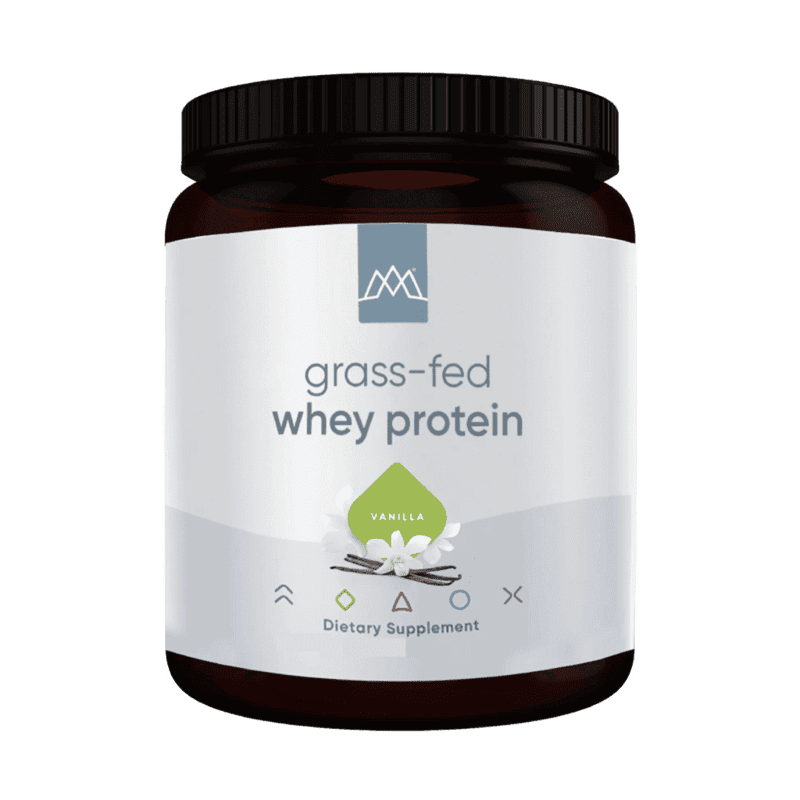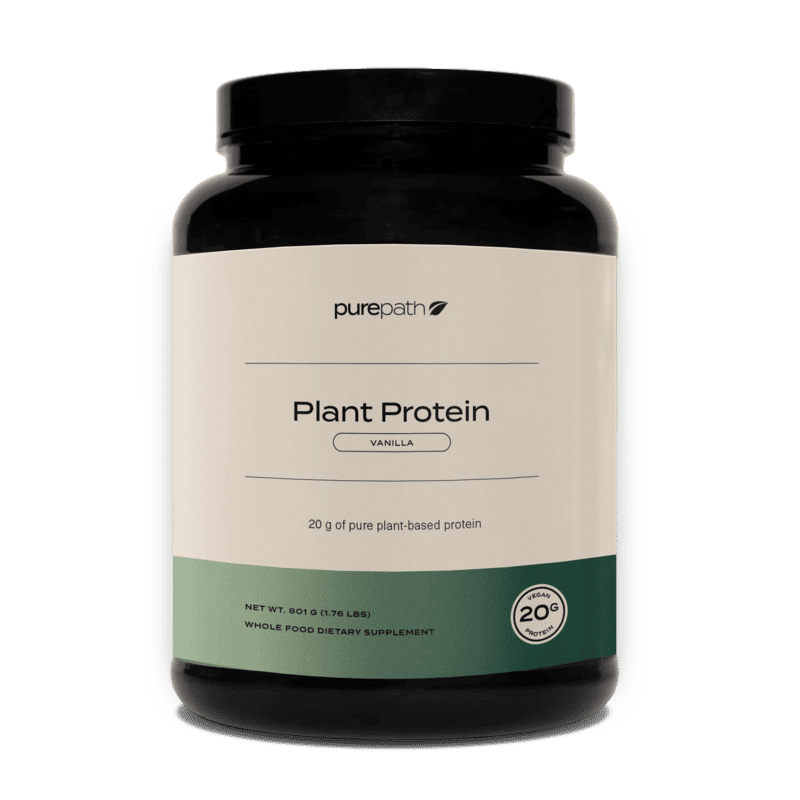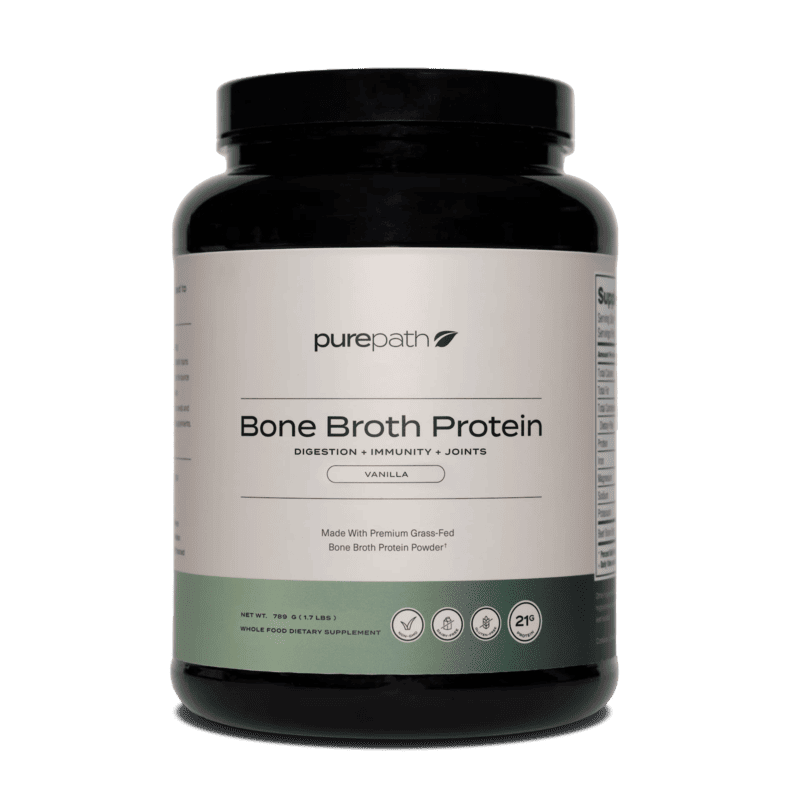Skip to:
- Essential Amino Acids
- Benefits of Different Protein Powders
- Whey Protein Powders
- Plant-Based Protein Powders
- Beef Broth Protein Powders
- Choosing the Best Protein Powder For You
- Designing the Perfect Protein Shake with Protein Powder
- Whey, Plant, or Bone Broth Protein? It’s Really the Quality that Counts!
Protein is Essential
“Protein” comes from the Greek word meaning first or primary. That makes sense considering that every cell in your body requires this macronutrient.
“Protein provides the building blocks for hormones and neurotransmitters and antibodies, not to mention being necessary for strong muscles and bones,” says Jonny Bowden, Ph.D., in The 150 Healthiest Foods on Earth, “It is essential for metabolism. Without protein, you would die.
Essential Amino Acids
Protein breaks down into 20 amino acids. Nine of those 20 are considered essential, meaning that your body cannot make them so you need to get them from food or supplements. Your body can synthesize the other amino acids that comprise protein from other sources, making them non-essential.
Sufficient protein intake is crucial to surviving, but also to thrive. The Dietary Reference Intakes (DRIs) suggest adults get 0.8 grams per kilogram (kg) of body weight daily. That’s about 56 grams of protein for sedentary men and 46 grams for sedentary women daily. Keep in mind, these numbers are to prevent deficiencies. For some people including active individuals, that requirement becomes higher (up to double the amount of protein) depending on your activity level.
Of course, you want to do more than prevent deficiencies. You want to give your body the amino acids it requires to function optimally and maintain vitality. Higher-protein diets — meaning more than the recommended amounts to avoid deficiencies and get protein’s many benefits — have specific advantages. Among them, getting sufficient amounts of protein can spare muscle during weight loss, promote weight management, enhance blood sugar regulation, and improve bone health.
Please confer with your healthcare specialist before you increase protein intake, especially if you have a kidney condition or other situation where higher protein intake would be contraindicated or potentially dangerous.
Benefits of Different Protein Powders
 Protein shakes using a protein powder are a convenient way to meet or increase your protein intake, whether you need a quick breakfast on the run, post-workout fuel, or something healthy to tide you over until your next meal. Protein shakes may also be a perfect meal replacement that mimics the nutrients you receive in a whole, nutrient-dense diet.
Protein shakes using a protein powder are a convenient way to meet or increase your protein intake, whether you need a quick breakfast on the run, post-workout fuel, or something healthy to tide you over until your next meal. Protein shakes may also be a perfect meal replacement that mimics the nutrients you receive in a whole, nutrient-dense diet.
Choosing a protein powder, however, can feel overwhelming with an ever-expanding variety at supplement stores, health food markets, and online stores. In addition, many protein powders may sometimes contain inferior ingredients. To put it simply, protein powders are not created equally and dramatically different in quality.
We’ve aimed to simplify your search and describe what to look for and what to avoid in protein powders, focusing on three popular choices.
Whey Protein Powders
Whey protein might be the most-researched of all protein powders, and for good reason. It contains immune-boosting proteins including beta-lactoglobulin, alpha-lactalbumin, and immunoglobulins. Whey also contains the precursors for glutathione, your body’s most abundant antioxidant. In other words, whey protein can optimize immunity.
Whey is also rich in the branched-chain amino acids (BCAAs) leucine, valine, and isoleucine, which constitute about 35% of the essential amino acids in muscle protein. Studies show BCAAs can stimulate muscle synthesis after weight resistance exercise.
Among its many benefits, whey protein can help you lose weight and build muscle. One 12-week study showed that a whey protein shake could improve fat loss and lean muscle mass in obese people. Another study shows whey protein can improve recovery after strenuous resistance exercise. Whey contains all 9 essential amino acids and ranks very high in protein quality rankings (including digestibility and absorption). Because it is low in the milk sugar lactose and other potentially reactive ingredients, people with dairy sensitivities can usually tolerate whey protein as well.

Quality is critical with whey protein. Those hulking containers you find in warehouse and fitness stores often contain added sugar, artificial sweeteners, and other undesirable ingredients. High-heat and other processing methods in cheaper whey protein powders can also damage the fragile amino acids. Choose an organic option like Grass-Fed Whey Protein Powder in either chocolate or vanilla.
Whey protein often comes either as a concentrate or isolate. While whey protein isolate often contains the highest amounts of protein, those proteins can become denatured due to the manufacturing process. If you choose to use whey protein, a whey concentrate provides a more well-rounded nutrient profile than whey protein isolate.
Whey is the Best Protein Powder For
- A pre- or post-workout fuel (because it absorbs quickly, whey makes an excellent powder to use around exercise)
- Immune support — research shows whey protein can support health in immunocompromised people including cancer and HIV
- People who otherwise want or need a quickly absorbable protein
- People who prefer the creaminess of dairy without its potential reactivity
Plant-Based Protein Powders
Whereas whey once ruled the protein powder shelves, plant proteins have become increasingly popular as a protein powder option. Chief among them is pea protein powder. Pea protein is not derived from the most common allergenic foods, making it ideal for those following restricted diets such as elimination diets. For those who avoid animal-derived foods, pea makes an ideal protein powder for vegans and vegetarians without the reactivity potential of soy protein powder.
This type of plant-based protein powder comes from ground yellow split peas. Manufacturers often separate the protein mechanically rather than chemically, creating less environmental impact. Pea protein has a solid amino acid profile, being especially high in lysine. This amino acid supports immune health and converts to L-carnitine, which converts fatty acids into energy.
Research shows plant-based protein can work just as well as whey protein. One 12-week study among 161 men (aged 18–35) who did resistance training used either pea protein, whey protein, or a placebo. All of them had a protein shake with 25 grams of either whey or pea protein or a placebo twice a day. The plant-based protein and whey protein performed about equally, and researchers concluded pea protein powder makes an acceptable substitute for whey protein powder.
Plant-based protein absorbs more slowly than other proteins such as whey, making it more satiating as a protein shake meal replacement. Some people find pea protein has a slight grittiness or creates gastric distress including gassiness. Combining pea with another plant-based protein solves most of these issues and gives the protein powder a more well-rounded nutrient profile including a more impressive amino acid profile.

One such option is hemp powder, derived from hemp seeds, which contains an impressive amount of anti-inflammatory fatty acids including gamma-linolenic acid (GLA). Research shows hemp can benefit heart health, blood pressure, cholesterol (lipid) levels, and more. Overall, adding hemp protein complements pea protein to provide a superior plant-based nutrient profile in a protein powder.
Choose a plant-based protein powder that combines pea and hemp for a complete source of protein, like Perfect Plant Protein, naturally flavored with vanilla.
Plant-based Protein is the Best Protein Powder For
- Vegans, vegetarians, and anyone who otherwise wants to avoid animal-derived protein powders
- People who want a more slowly absorbing protein powder
- People with strong dairy or other food intolerances
Beef Broth Protein Powders
A newer player among protein powders is a beef-based protein powder, which mimics the nutrient profile of bone broth. “Bone broth isn’t just broth. And it isn’t just soup. It’s concentrated healing,” says Kellyann Petrucci, ND, in Dr. Kellyann’s Bone Broth Diet. “This broth, made from meat, poultry, or fish bones and simmered on the stove for hours until it turns into nutrient-rich ‘liquid gold,’ is one of the world’s oldest and most powerful medicinal foods,” Petrucci remarks.
At the same time, bone broth can take time and patience to make. Thankfully, beef protein powder mimics bone broth with a similar nutrient profile and higher content of collagen-specific amino acids (proline and glycine).

Animal studies show collagen supplements can support skin health and help combat the aging process. One study with elderly men found that compared with a placebo, a collagen peptide supplement combined with resistance training increased muscle mass and fat loss.
Overall, beef has a high protein score and an impressive amino acid profile because it contains a similar balance of essential amino acids to those found in human skeletal muscle. Beef protein powder provides that same superior amino acid profile. MaxLiving beef protein powders are made with HydroBEEF™, a highly concentrated beef protein sourced from animals raised in Sweden without hormones. The manufacturing process allows the protein to be hydrolyzed or split into a high concentration of functional peptides (2 or more amino acids linked together), allowing for easier absorption and assimilation.
Beef protein compares favorably with other protein powders. One study found that two servings of either beef protein or whey protein following resistance training significantly increased fat loss, lean mass, and strength about equally.
Beef Protein Powder is the Best Protein Powder For
- People who want a true Paleo protein, free of more modern-day foods including dairy and legumes
- People who want a similar nutrient profile of bone broth without the work of making bone broth
- People who want a cost-effective way to get beef’s superior protein without eating meat
Choosing the Best Protein Powder For You
Adding protein powder to smoothies, shakes, other liquids, and stirring into foods like yogurt is an excellent way to boost your protein intake easily. For an organic whey protein, consider Grass-Fed Whey Protein. If you prefer plant-based protein powders, check out Perfect Plant Protein. These guidelines can help you make the right decision choosing among protein powders:
- Optimal amounts of protein: While amounts will vary in each variety, every serving of powder should provide at least 20 grams of protein.
- Free of reactive ingredients: Casein (from milk), soy, and gluten can create food sensitivities in some individuals. Closely inspect ingredients and avoid protein powders that contain these types of protein.
- Taste and texture: There are many flavors of protein powders, the most common being chocolate or vanilla. Many manufacturers also offer unflavored powders that work fine when you mix them with other ingredients. Some have a smoother texture. Pea might feel slightly gritty, whereas beef or whey protein powders are creamier. Taste is subjective, but experiment with a few different types of protein powders to see what works for your palate.
- Reputation: Even when manufacturers make certain health claims and mention ingredients such as “natural flavors,” the only way to truly know whether a protein powder is healthy is to purchase from a company with a stellar reputation.
- Ingredients: As a general rule, the fewer ingredients, the better.
- No artificial sweeteners: Avoid powders with aspartame, sucralose, and other artificial sweeteners. Small amounts of natural sweeteners like organic stevia are fine.
- Low in added sugar: While protein powders might contain a small amount of naturally occurring sugar, avoid those with added sugars or those that contain more than a few grams of overall sugar.
- Additional nutrient support: Well-rounded protein powders sometimes contain other nutrients to mimic the nutrient profile found in whole foods. Those nutrients might include vitamins, minerals, probiotics, digestive enzyme support, and/ or a vegetable blend.
Designing the Perfect Protein Shake
Once you’ve figured out what protein powder to use, you can be creative and add ingredients to design a shake that’s perfect as a snack, around a workout, or as a meal replacement. Among the ingredients that make the perfect protein shake include:
- Unsweetened nut milk (almond, cashew, coconut)
- Fresh or frozen berries
- Unsweetened nut butter (like almond butter)
- Cacao nibs (high in fiber and low in sugar)
- Avocado (provides a creamy texture to shakes)
- Leafy greens (an easy way to slip them in for kids. They won’t taste them!)
- Liquid fish oil — this is great for kids or anyone who doesn’t like to swallow fish oil
- Freshly ground flaxseeds or chia seeds
It’s Really the Quality that Counts!
Protein powders might be the most versatile, easy-to-use source of protein available that helps you increase your protein intake and gain all its benefits. Talk with your chiropractor or other healthcare professional about intelligently increasing your protein intake from food and supplements. Some people might do better, for instance, with more than one serving of protein powder.
Quality matters! Choosing the right protein powder is critical to avoid the sweeteners, potential food sensitivities, and otherwise-undesirable ingredients many commercial protein powders contain.



